Gigabyte Z77X-UP7 Review: OC Oriented Orange Overkill
by Ian Cutress on March 1, 2013 10:30 AM EST- Posted in
- Motherboards
- Intel
- Gigabyte
- Z77
MultiCore Turbo
Frequent readers of our motherboard reviews at AnandTech will have come across the term MultiCore Turbo. In a nutshell, when XMP is enabled, the motherboard adjusts the multiplier of the CPU to its highest Turbo bin for all loading – such that instead of 39x/39x/38x/37x for an i7-3770K, we get 39x across the board. This has obvious implications for multithreaded workload, which we explained and ‘asked the readers’ in a recent news item. Most motherboard from the major manufacturers (ASUS, Gigabyte, and now ASRock + MSI) has this option enabled by default when XMP is enabled, or a variation therein. It was originally designed to help certain users with software that had variable loading to stay stable, as well as speed them up to a small degree – the knock on effect is that for reviews, it shows up in the benchmarking when testing the out-of-the-box performance. For users intending to overclock, MCT is nothing to worry about.
For the Gigabyte Z77X-UP7, MultiCore Turbo is part of the BIOS used in testing.
3D Movement Algorithm Test
The algorithms in 3DPM employ both uniform random number generation or normal distribution random number generation, and vary in various amounts of trigonometric operations, conditional statements, generation and rejection, fused operations, etc. The benchmark runs through six algorithms for a specified number of particles and steps, and calculates the speed of each algorithm, then sums them all for a final score. This is an example of a real world situation that a computational scientist may find themselves in, rather than a pure synthetic benchmark. The benchmark is also parallel between particles simulated, and we test the single thread performance as well as the multi-threaded performance.
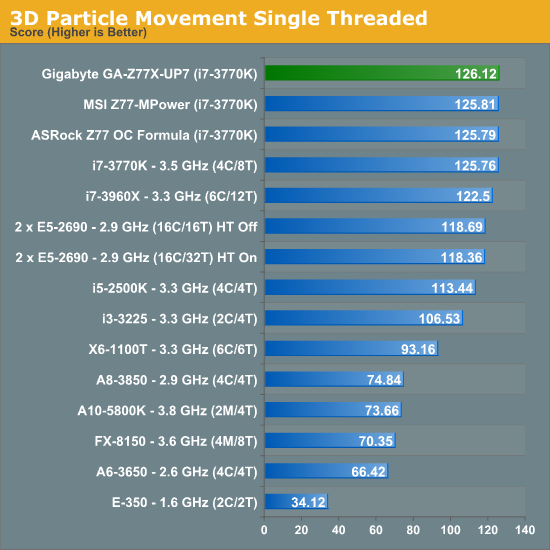
The single threaded version of 3DPM is more of a task in efficiency than anything else, and the UP7 hits the high notes, above the Z77 OC Formula and MPower, with ease.
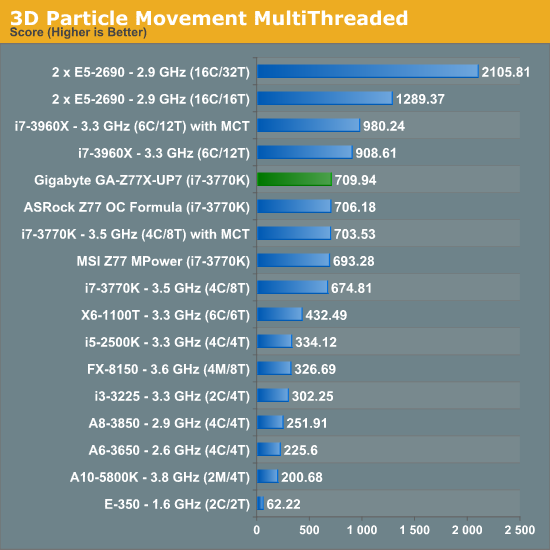
The Gigabyte Z77X-UP7 quite handsomely takes the 3DPM-MT crown out of all the Z77 motherboards using MCT, above the Z77 OC Formula. (The G1.Sniper 3 uses MCT-Plus, rising up to 4.0 GHz.)
WinRAR x64 3.93 - link
With 64-bit WinRAR, we compress the set of files used in the USB speed tests. WinRAR x64 3.93 attempts to use multithreading when possible, and provides as a good test for when a system has variable threaded load. If a system has multiple speeds to invoke at different loading, the switching between those speeds will determine how well the system will do.
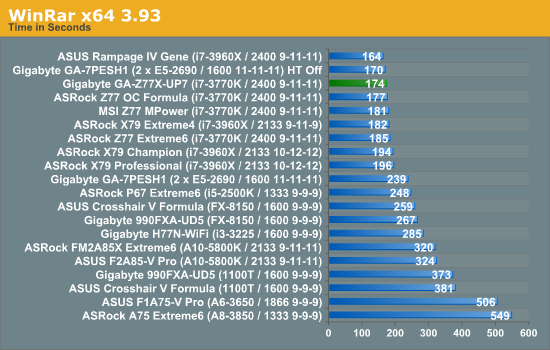
The efficiency shown in 3DPM-MT follows through to WinRAR, where the UP7 is two seconds behind the top Z77+MCT motherboard, and three seconds ahead of the ASRock Z77 OC Formula.
FastStone Image Viewer 4.2 - link
FastStone Image Viewer is a free piece of software I have been using for quite a few years now. It allows quick viewing of flat images, as well as resizing, changing color depth, adding simple text or simple filters. It also has a bulk image conversion tool, which we use here. The software currently operates only in single-thread mode, which should change in later versions of the software. For this test, we convert a series of 170 files, of various resolutions, dimensions and types (of a total size of 163MB), all to the .gif format of 640x480 dimensions.
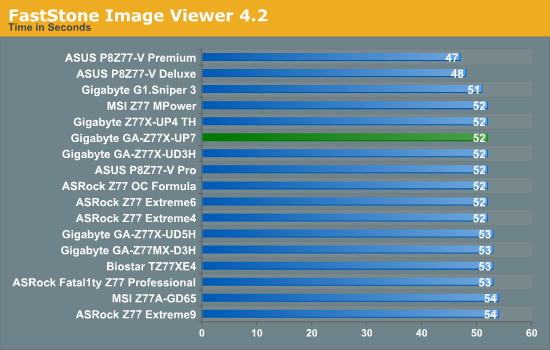
Across the range FastStone shows up very few variances due to its single-threaded runtime. The UP7 fits in the 52 second category, along with most Z77 boards. The high end ASUS boards are still kings for FastStone.
Xilisoft Video Converter
With XVC, users can convert any type of normal video to any compatible format for smartphones, tablets and other devices. By default, it uses all available threads on the system, and in the presence of appropriate graphics cards, can utilize CUDA for NVIDIA GPUs as well as AMD APP for AMD GPUs. For this test, we use a set of 32 HD videos, each lasting 30 seconds, and convert them from 1080p to an iPod H.264 video format using just the CPU. The time taken to convert these videos gives us our result.
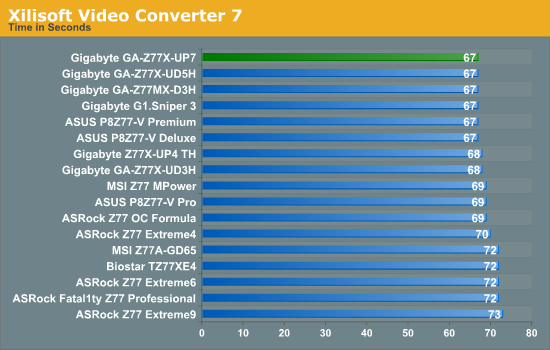
At full loading across all threads to convert video, and some memory overhead, all Z77 motherboards have fit in the 67-73 second window, albeit making ~9% from top to bottom. The UP7, like most Gigabyte boards, fits in the 67 second bracket, two seconds ahead of the ASRock Z77 OC Formula and MSI Z77 MPower.
x264 HD Benchmark
The x264 HD Benchmark uses a common HD encoding tool to process an HD MPEG2 source at 1280x720 at 3963 Kbps. This test represents a standardized result which can be compared across other reviews, and is dependant on both CPU power and memory speed. The benchmark performs a 2-pass encode, and the results shown are the average of each pass performed four times.












41 Comments
View All Comments
Beenthere - Saturday, March 2, 2013 - link
Don't be concerned about the $400 entry fee to the Pumpkin fanbois club, as there are quite a few kids able to spend Mommy's money on impractical toys. Asus has proved that there are many PC enthusiast suckers born every minute so Gigabyte might as well cash in on the technically dumbness, too.CeriseCogburn - Sunday, March 3, 2013 - link
With the amount of technically challenged I see here at Anand that proclaim otherwise I don't believe it has anything to do with hype for pretty colors or expensive items.Most people don't have a clue, a few have a bit, and those that do keep learning, it doesn't relate to pocketbook depth or how money is "foolishly spent", or how jealous the poorboy crybabies are when others buy the best of the best, as your personal life experience should tell you.
Without extravagant waste widespread the world would still be a 3rd world dirtbag hole, everywhere.
Pretty sick of the new crybaby constant whines - if the group of whackos isn't squealing penny pinch bang for the buck, they're whining about top end items.
I think we need a new "computer blog law" or two in order to outline the pervasive complaint themes that have become popular.
Uber_Roy - Wednesday, March 6, 2013 - link
LoL give this man a prize funnest shit i seen in a while :Pehume - Saturday, March 2, 2013 - link
And now we seem to be able to survey the field. So, looking down from this height, what would you recommend for someone who wants to get the highest overclock from a 3770k, using the lowest Voltage (thus producing the lowest temps) and doesn't do any gaming?Sniper boards seem unnecessarily fancy, with too much emphasis on GPU's. The ASRock Z77 Extreme6 or Extreme4 seem OK, but maybe not great. Somewhere between those ends is a sweet middle spot for a simple overclocker.
Given a year of Ivy Bridge, what would you recommend?
C.C. - Saturday, March 2, 2013 - link
The ASROCK Extreme4 would work perfectly for your needs! I have done several builds using the Extreme 4 and I 3770Ks. They are simply the best bang for the buck motherboard. You get all the features you need, at an awesome price. I am currently running an i7 3770K with the IHS removed (aka de-lidded) @ 4.8Ghz @ 1.272V..I have run a 48hr Prime95 stress test, and with watercooling and CL Liquid Ultra TIM, max core temps are 45,43,53,and 44C. The CL ultra is amazing, it doubled my thermal gains from de-lidding. I was using IC Diamond, and max temps were 74,73,85,and 75C.CeriseCogburn - Sunday, March 3, 2013 - link
I agree they have been pushing out some great deals for some time, although there are other brands that do well at good prices too.(I don't quibble about $5, $10, $20, $30, or $50 bucks)
IanCutress - Sunday, March 3, 2013 - link
I would never suggest aiming for the highest overclock from a CPU to run in a 24/7 machine. Find the best, then dial it back a few notches so you hit a sweet spot in terms of performance/power usage/temperatures.Ivy Bridge CPUs can vary so much, where one CPU off the shelf could take 0.1 volts less than another to hit the same clocks. For a 24/7 system, I would rather go with a motherboard that makes it easy to overclock to a nice speed rather than one that necessarily does the best. And what is the best motherboard? It's hard to tell - every CPU curve is different - is the best board one that could take a mediocre processor to new heights, or one that has the ultimate capacity to take the most expensive and best CPUs to the top in terms of performance?
Then it all comes down to price. The ASRock Z77 OC Formula, ASUS P8Z77-V Pro and GIgabyte Z77X-UD5H are all around the $210 (+/- $30) mark that will happily take a good Ivy Bridge processor to 4.8 GHz. I still have the ASUS Maximus V Formula and Gene to review shortly, as well as the G1.Sniper M3.
CeriseCogburn - Sunday, March 3, 2013 - link
LOL, good luck at the OC'ing tunaman.stren - Tuesday, March 5, 2013 - link
If you're repeating the gaming benchmarks then let's stress the PLX chip next time - 4xCF won't do that:- Use Nvidia cards because they use a ton more pci-e bw than the amd cards
- Preferably 3/4xTitans or 4x 680s as they have the most potential to be pci-e limited
- Run at super high resolutions. E.g. 3x1080p minimum, preferably 3x1440p.
This is where vega saw pcie bw issues really show up. A good comparison would be versus the R4E and the Asrock X11. I.E. native 8x8x8x8x vs PLX 8x8x8x8x vs 2xPLX 16x16x16x16x However as both those boards are x79 though I would suggest just maxing out the cpu clock rather than equalizing it as this is more fair and representative of what the high end users would do.
iamkyle - Thursday, March 7, 2013 - link
There is one thing I loved about the previous iteration of this board being the X58A-OC - the minimalist I/O panel. Although it didn't go far enough in my opinion, it was a delight to behold.The whole bit about the enthusiast community is customization - the ability to change out whatever setups they want in regards to video, ram, cooling, you name it. But yet the manufacturers still continue to force choices in sub-par audio codecs and NIC choices.
The ideal enthusiast board should be devoid of of any excess I/O outside of USB ports. I should be able to put in my audiophile-grade sound card, enterprise-class NIC, what have you without the extras being thrown in. That is true choice.